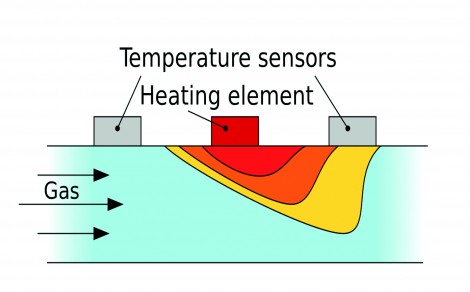Managing losses in compressed air systems with thermal mass flow technology

Monitoring compressed air usage within industrial applications has become increasingly important as the associated costs continue to rise dramatically.
Compressed air systems are often the largest excess user of electricity for a business, with air leaks or poorly performing components contributing to a significant amount of wasted energy. In this age of energy efficiency to ensure a greener footprint, it is becoming more important for all businesses to identify and rectify any potential energy wastage situations. Problem areas in compressed air systems can be identified by fitting thermal mass flow meters, strategically positioned to calculate outflow generated air with downstream usage.
There are several traditional ways of measuring the flow of compressed air in a system, using orifice plates and turbine or vortex meters for example, which will measure the ‘actual' uncompensated volumetric flow of air. However, it is often more important to have a corrected flow rate linked to a particular pressure and temperature at ‘Normal conditions'. This requires a multi-variable solution which can be expensive to buy and maintain and may also increase the chance of errors considering the extra sensors required.
Thermal mass flow meters are an ideal solution for compressed air measurements as they measure the mass flow of the air directly, removing any need to monitor the pressure and temperature separately. Compressed air thermal mass flow meters are effective tools for monitoring and managing energy consumption. According to Bell Flow Systems, they can detect leakages much faster than a pressure sensor, they can be used for cost allocation and they can be used for efficiency monitoring and maintenance management.
What is thermal mass?
In the Thermal Mass Principle image shown, Bell Flow Systems’ MEMS (CMOS) type Thermal Mass flow meter senses flow via the convective heat transfer flow measurement principle. A micro-heater is placed in the middle of two temperature sensors symmetrically positioned at upstream and downstream points. The cavity below the micro-heater and sensors plays the role of thermal isolation as it is filled with the gas. When the flow passes through the micro-heater, heat is carried away by the flowing medium, with the temperature differences measured by the up and down-stream temperature sensors being directly proportional to the mass flow of the compressed air or gas being measured.
Why thermal mass?
There are many advantages to this method of air flow measurement. These types of sensors feature zero moving parts in a nearly unobstructed straight through flow path, which facilitates extremely low pressure drop measurement. Maintenance costs are low and this type of meter is very sensitive at low flow rates, which allows for a high turn-down ratio whilst remaining accurate over a wide measuring range. Insertion style models can also be used in larger pipe sizes, with the option to install via a Hot-tap kit under full system pressure. We recommend placing thermal mass flow meters in dry air downstream of all air treatment filters to prevent sensor degradation. If temperature changes rapidly, this can affect the accuracy of the flow meter and can shorten its service lifetime as well. Large temperature variations, which can be found downstream of malfunctioning desiccant dryers, should be avoided
Thermal mass from Bell Flow Systems
Bell Flow Systems offers a range of thermal mass flow meters designed for measurement of compressed air and Nitrogen. The TGF200 series are a smaller bore inline range starting at DN8 up to DN50 in size and the TGF450 and TGF600 series are supplied as flanged or insertion style units designed for pipes form DN25 to DN500. All these models have digital and analogue 4-20mA outputs with optional communication outputs such as Modbus RS485 and HART. Bluetooth is available with complimentary mobile phone app allowing the user to check and set meter parameters. It is also ideal for when the operator needs to view readings in hard to reach locations and provides efficient viewing when multiple meters are installed.
The TGF200 has four flow ranges with a 100:1 turndown ratio for each of the eight sizes, designed to suit the requirements of a variety of applications. This rugged unit is ideal for various industrial applications in factories, workshops and garages as it can be constructed from aluminium or stainless steel. With a fast response time of 160ms, this flow meter has a high accuracy level of +/-0.3% F.S and the meter can handle temperatures up to 100degc
The TGF450 and TGF600 flanged and insertion models are claimed to be ideal where the supply cannot be turned off or delayed in terms of installation and maintenance. These can be installed and removed via hot-tap connection if required, reducing costs and production delays. These models feature simple operator programming and it is also possible to adjust the flow calculation. These both have a two-line LCD display which can show both the rate of flow and total volume. The display can show volumetric and mass flow in kg or ton with the addition of programming options for alternative gas densities.
-
Farnborough International Airshow
22 - 26 July, 2024
Farnborough International Exhibition & Conference Centre










